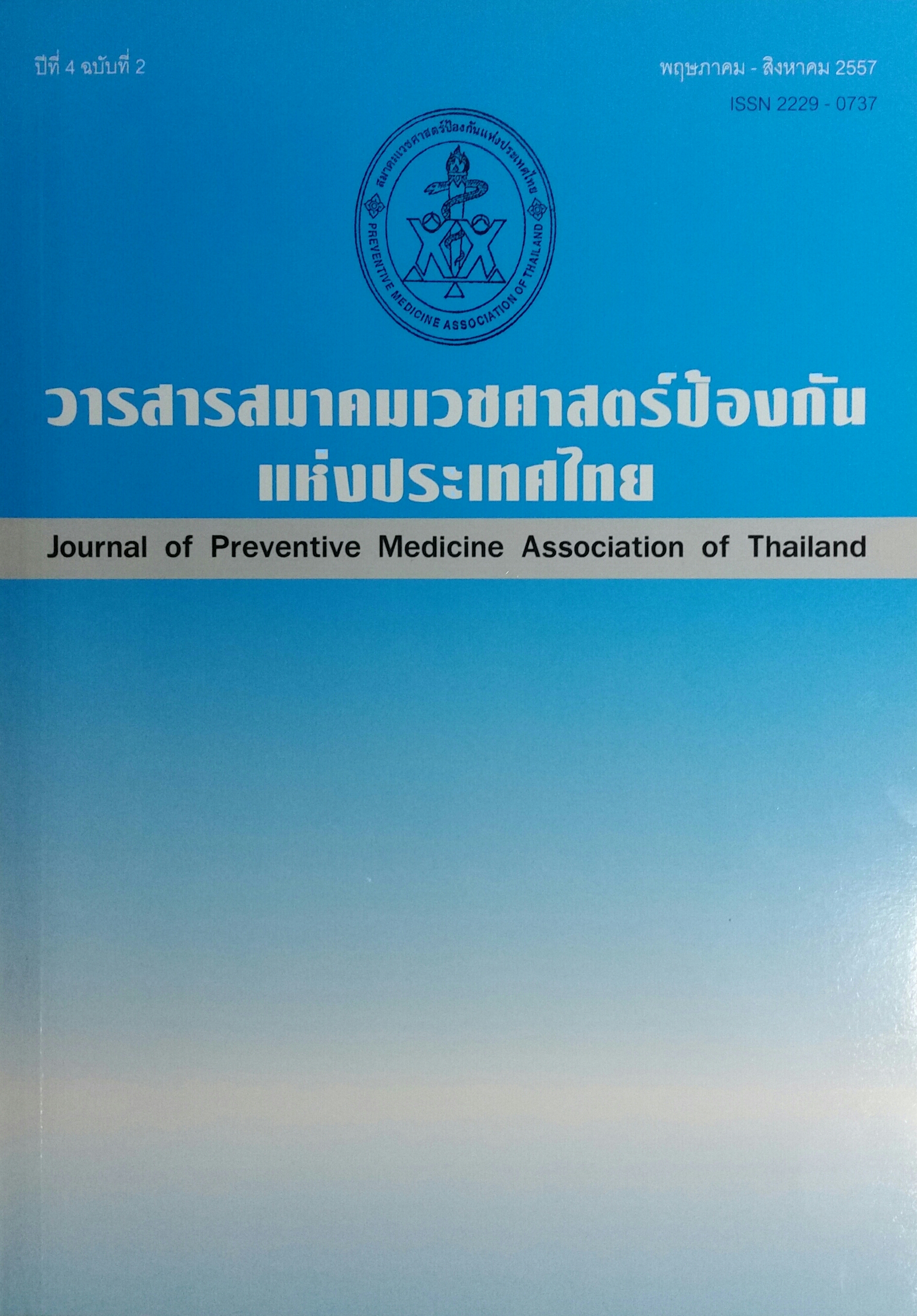Effects of Discharge Planning and Telephone Follow up on HbA1c and Nursing Service Satisfaction of Diabetic Patients and Nurse’s Job Satisfaction
Keywords:
Discharge planning and telephone follow up, HbA1c, diabetes mellitus patients, patient’s satisfaction of nursing service, nurse’s job satisfactionAbstract
The purposes of this research were to study 1) effects of discharge planning and telephone follow up on HbA1C of diabetic patients 2) patient’s satisfaction of nursing service and 3) nurse’s job satisfaction. Subjects were 70 patients who were purposively assigned to an experimental group and a control group, 35 in each group, and 35 nurses who worked at the clinic medicines. The experimental group utilized discharge planning and telephone follow up. The control group utilized routine nursing care. The research instruments included discharge planning and telephone follow up training program for quality of nursing care, patient’s satisfaction with nursing service, and nurse’s job satisfaction questionnaires. Reliability value 0.75 and 0.80. All data were analyzed by mean, standard deviation, independent t-test and dependent t-test. Major results were as follows : HbA1c in diabetic patients who received the discharge planning and telephone follow up program were less than those of the diabetic patients who received routine nursing care, at the 0.5 level (=7.87) Patient’s satisfaction with nursing service related to discharge planning and telephone follow up were significantly higher than that of diabetic patients who received routine nursing care, at the 0.5 level (
=4.21 and 3.81, respectively) Nurse’s job satisfaction after using discharge planning and telephone follow up was significantly higher than before using discharge planning and telephone follow up, at the 0.5 level. (
=4.33 and 4.09, respectively).
References
2. รุจา ภู่ไพบูลย์. การดูแลสุขภาพที่บ้าน: แนวคิดพื้นฐานสำหรับอนาคต. ใน: การประชุมวิชาการสมาคมศิษย์เก่าพยาบาลศิริราช ในพระบรมราชูปถัมภ์ของสมเด็จพระศรีนครินทราบรมราชชนนี ครั้งที่ 9 เรื่อง ครอบครัวในยุคโลกาภิวัตน์ต่อบทบาทพยาบาลที่ก้าวไกล”. 2547. (หน้า 52-9).
3. ทัศนา บุญทอง. ปฏิรูประบบบริการพยาบาลที่สอดคล้องกับระบบบริการสุขภาพไทยที่พึงประสงค์ในอนาคต. กรุงเทพฯ: ศิริยอดการพิมพ์. 2551.
4. ประภัสศรี ชาวงษ์. การพัฒนารูปแบบการวางแผนจำหน่ายผู้ป่วยบาดเจ็บที่ศีรษะที่รับการรักษาในโรงพยาบาลขอนแก่น. (วิทยานิพนธ์คุรุศาสตรมหาบัณฑิต) สาขาการบริหารการพยาบาล, บัณฑิตวิทยาลัย. กรุงเทพฯ: จุฬาลงกรณ์มหาวิทยาลัย 2551.
5. Evan C. Postpartum home care in United States. JOGNN 1995:24(2):180-6.
6. McBride, C.M. & Reimer, B.K. Using the telephone to improve health behavior and health service delivery. Patient Education and Counseling 1999:37:3-18.
7. Shu, E., Mermina, Z., & Nystrom, K. Telephone reassurance program for elderly home care: Clients after discharge. Home Healthcare Nurse 1996:14(3):155-16.
8. Stricklin, M. L. V., Jones, S., & Niles, S. A.Home talk/healthy talk: Improving patients health status with telephone technology. Home Healthcare Nurse 2000:18(1):53-61.
9. สมศักดิ์ สินเสถียรพร. ประสิทธิผลการสอนอย่างมีแบบแผนต่อการดูแลตนเองและควบคุมโรคของผู้ป่วยเบาหวาน ชนิดไม่พึ่งอินสุลินโรงพยาบาลปทุมธานี. วารสารโรงพยาบาลนพรัตน์ราชธานี. 2549.
10. McKeehan, K.M. Continuing care : A multidisciplinary approach to discharge planning. St. Louis: The C.V. Mosby. 1981.
11. Hucy, A, Chronic illness: impact and intervention. 5th ed. Boston: Jones and Bartlett. 1986.
12. Davis, K. Human relation at work: The dynamic of organizational behavior. New York: McGraw Hill. 1995.
13. McClelland, E., Kelly, K., & Buckwalter, K.C. Continuity of care: Advancing the concept of discharge planning. London: Grune & Stratton. 1985.
14. Elliott, S. & Reimer, C. Post-discharge telephone follow-up program for breastfeeding
15. Cave L.A, Follow-up phone calls after discharge. American Journal of nursing 1999:89(7):942-3.
16. พรทิพย์ เกยุรานนท์. รูปแบบการดำเนินงานการดูแลสุขภาพที่บ้านของโรงพยาบาลในสังกัดของโรงพยาบาลภูมิภาค กระทรวงสาธารณสุขในทศวรรษหน้า. (วิทยานิพนธ์ปริญญาสาธารณสุขดุษฎีบัณฑิต). สาขาวิชาการพยาบาลสาธารณสุข, บัณฑิตวิทยาลัย. กรุงเทพฯ: มหาวิทยาลัยมหิดล. 2549.
Downloads
Published
How to Cite
Issue
Section
License
บทความที่ลงพิมพ์ในวารสารเวชศาสตร์ป้องกันแห่งประเทศไทย ถือเป็นผลงานวิชาการ งานวิจัย วิเคราะห์ วิจารณ์ เป็นความเห็นส่วนตัวของผู้นิพนธ์ กองบรรณาธิการไม่จำเป็นต้องเห็นด้วยเสมอไปและผู้นิพนธ์จะต้องรับผิดชอบต่อบทความของตนเอง






